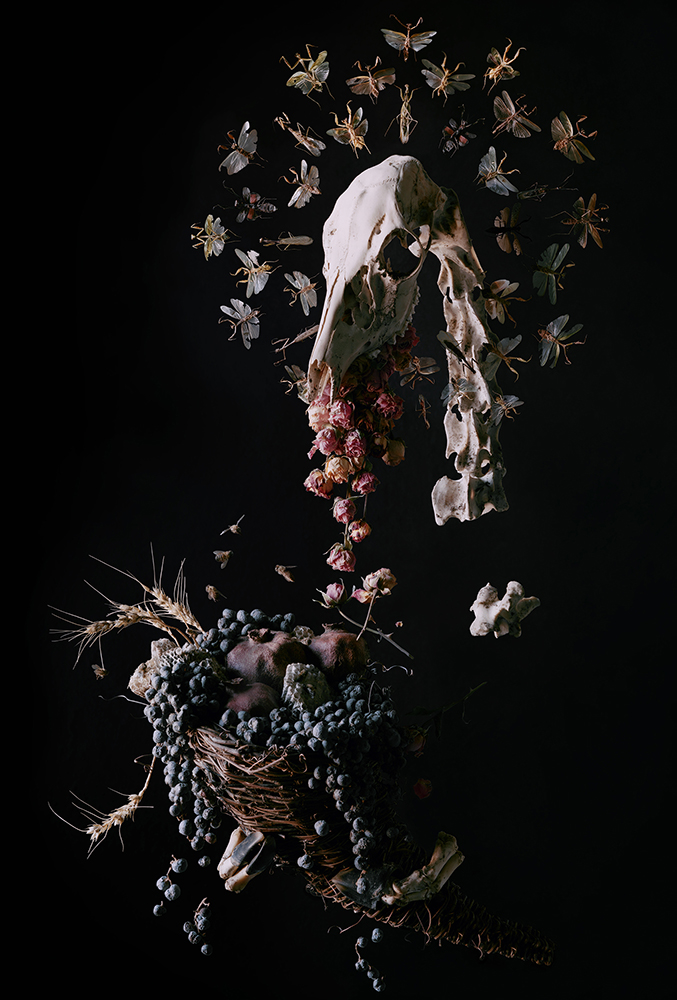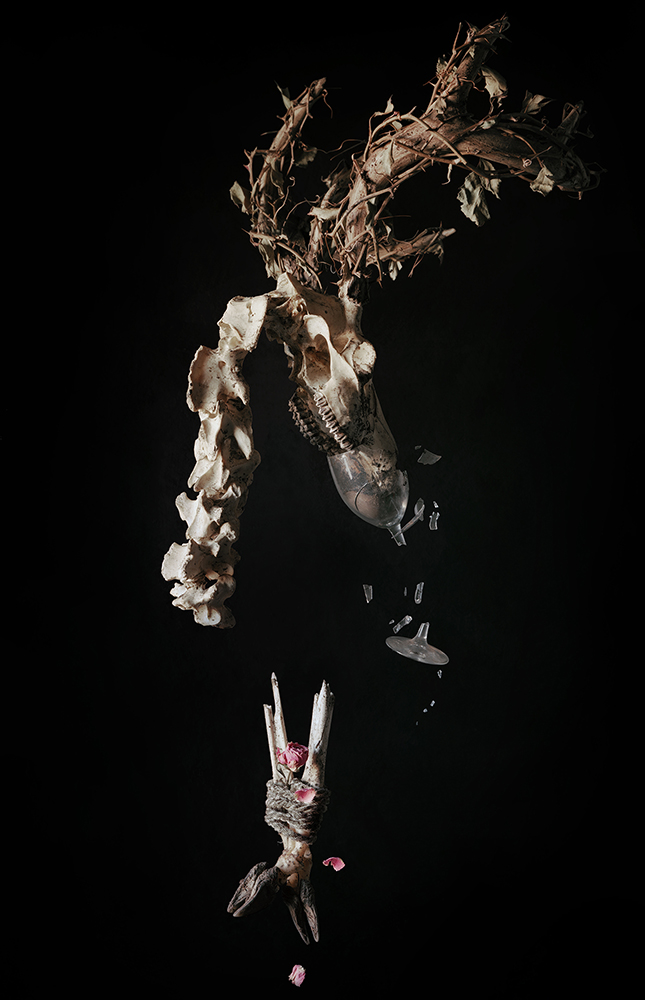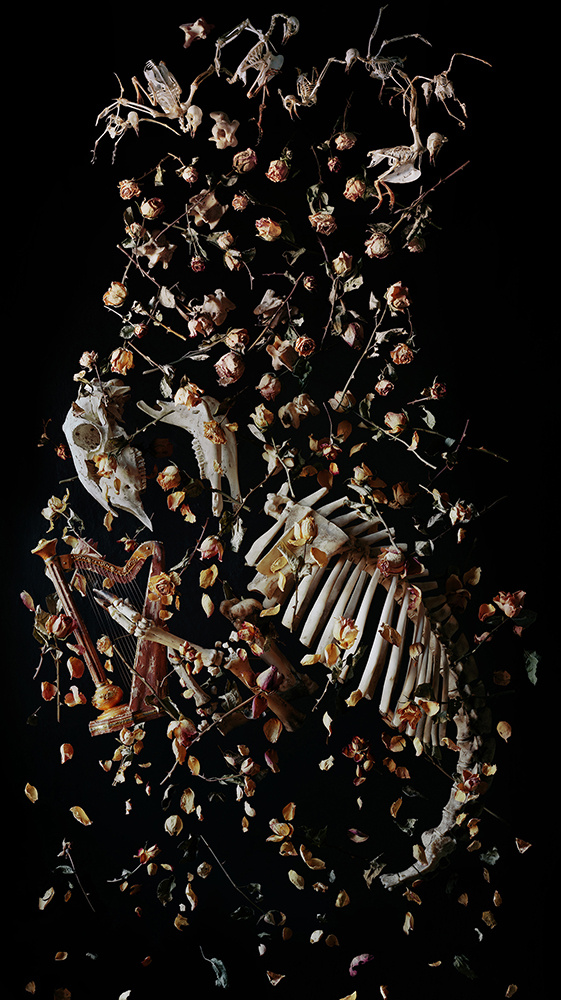Tara Sellios: Ask Now the Beasts
What happens to us as we leave this life? How do our remains deteriorate and how does our spirit pass on? Deep, philosophical questions such as these are what come to mind when looking at the hauntingly beautiful work of Tara Sellios. Utilizing biblical imagery such as insects, dried fauna, and bone, Sellios fabricates elaborate still-life imagery that feels as though the photo breathes alongside its viewer, waiting for us to delve into obscurity. “Ask Now the Beasts” is imbued with themes of religion, spirituality, and the ideas of life and death, all of which conjure the ideas of what happens once our time on Earth is over and where our spirit goes to rest.
Tara Sellios is a multidisciplinary artist working mainly in large format photography and also in drawing, sculpture and installation. She graduated from The Art Institute of Boston in 2010 with a BFA in photography and art history. Recent solo exhibitions include Infernalis at Gallery Kayafas (Boston, MA), Sinuous at C. Grimaldis Gallery (Baltimore, MD) and Testimony at Blue Sky Gallery (Portland, OR). Her work has been included in several group exhibitions locally and internationally, the most recent being inclusion in a group exhibition at Castello Baradello (Como, Italy) and Photo Brussels Festival (Brussels, Belgium). She is a multiple Massachusetts Cultural Council Award Fellow and has appeared on the cover of Photograph magazine and Art New England, amongst others. Her work is part of several permanent collections, including The Museum of Fine Arts Boston, The Danforth Museum and the RISD Museum. She currently lives and works in her South Boston studio, where she is preparing for her next solo exhibition at Fitchburg Art Museum in 2025, as well as many group exhibitions. Her visceral, highly detailed photographs are intensely planned and process oriented, often using organic matter like animal skeletons and real, dried insects. Using an 8×10 view camera, she photographs these arrangements which result in dramatic, painterly still-life photographs wrought with sensuality, lightness and darkness, and religious symbolism.
Follow Tara Sellios on Instagram: @tarasellios
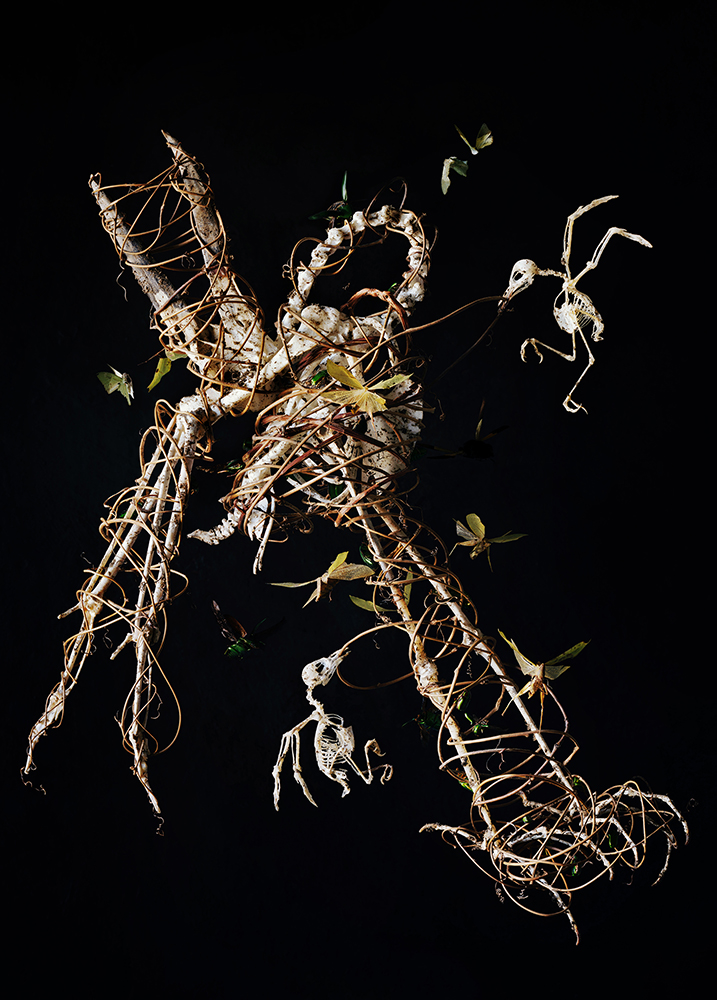
©Tara Sellios, Amans No. 1 (Ask Now the Beasts), 2022, 60×43 inches, inkjet print from 8×10 negative
Ask Now the Beasts
I strive to create images that elegantly articulate the totality of existence, focusing heavily on life’s underlying instinctive, carnal nature in the face of fragility and impermanence. The concept of morality in relation to mortality has possessed a significant presence within the history of art, ranging from religious altarpiece imagery to the work of the vanitas painters. Manifesting melancholic themes with beauty, precision and seduction forces the viewer to look, despite its grotesque and morbid nature. Through these images, I aspire to make apparent the restlessness of a life that is knowingly so temporary and vulnerable.
Ask Now the Beasts derives its title from the Biblical text of Job. The symbolism in these frames conjure ideas of the cyclical nature of the earth in relation to the concept of the harvest. Once a time of prosperity, richness and eroticism, the offerings here are withered on the vine. Light strikes from the left as if to indicate the passage of days grown too long. The earth passes away, but that is not to say that there is no hope – suffering and death leads to transcendence and transformation. Within the dance between light and darkness, beauty and celebration can still be found. These images are to be a part of a large, altarpiece structure wrought with complex references and allusions influenced by stained glass windows, illuminated manuscripts, and other genres of religious imagery intended for meditation, storytelling and reverence. -Tara Sellios
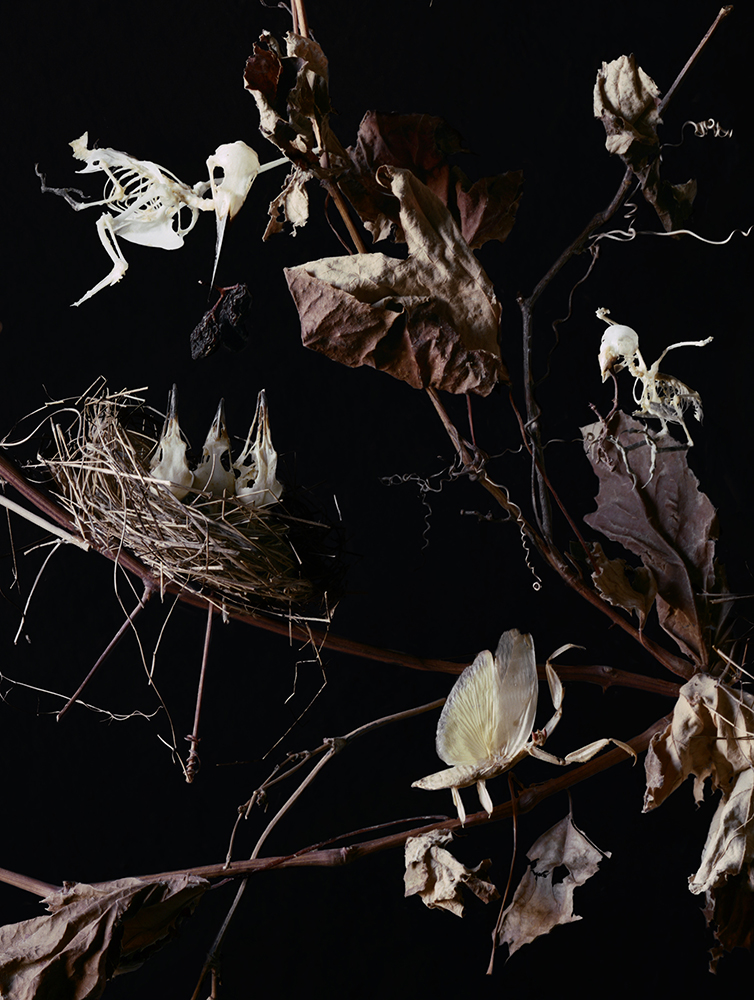
©Tara Sellios, (Detail) Vinea (Ask Now the Beasts), 2023, 120×64 inches (full image), inkjet print from 8×10 negative
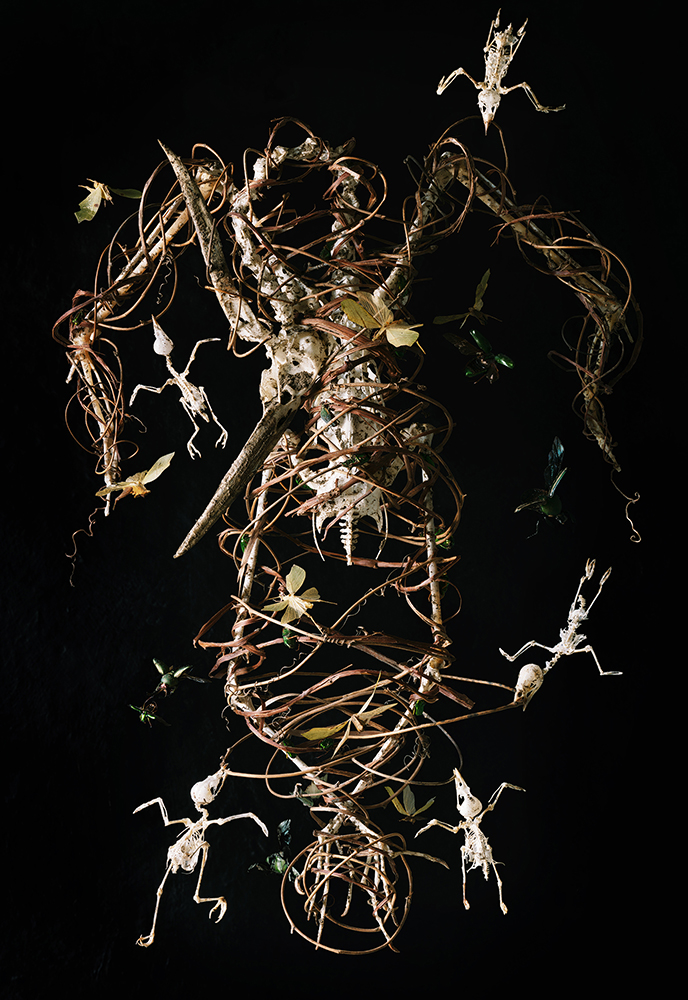
©Tara Sellios, Amans No. 2 (Ask Now the Beasts), 2021, 60×43 inches, inkjet print from 8×10 negative
Kassandra Eller: To start, I just want to say the way you photograph is captivating. I find myself continually going back to each piece, and finding something new to reflect on. I would love to know how the idea for this project came about.
Tara Sellios: Thank you. There is a lot of detail! Everything tells a story. Ask Now the Beasts began with the pieces Messis No. 1 and 2, the harvesting sickles infested with leaf mimic insects of various kinds. I wanted to directly reference the idea of the grape harvest in a very earthy way. We will go more into the influences of my work later in the interview, but I started thinking about the “grape harvest of the apocalypse” in the Biblical text Revelation, where at the end of the world, angels cut the grapes from the vine and throw them into the “wine press of the wrath of god”. This is a heavy reference and concept, but something I’ve been exploring in my work the past few years is a new world or new direction of the world where the earth takes over and thrives, hence the insects. The rest of the images then began to birth from that place.
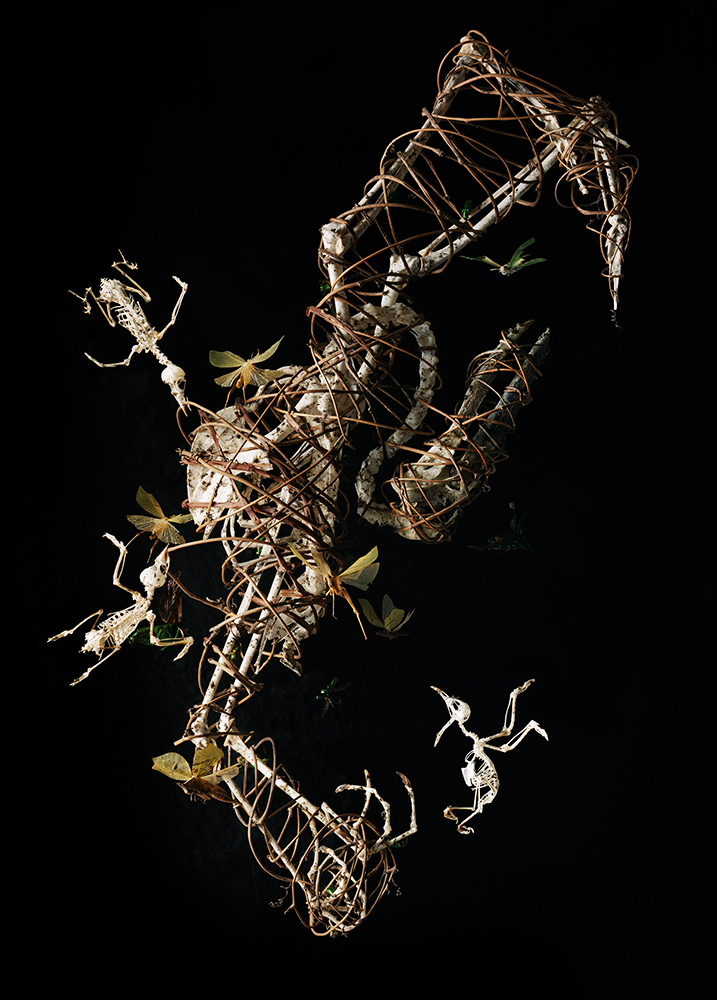
©Tara Sellios, Amans No. 3 (Ask Now the Beasts), 2022, 60×43 inches, inkjet print from 8×10 negative
KE: Were there any artists that inspired you or this project?
TS: Probably many, and I’m still making images for the project so it’s changing as time goes on, but I spent a lot of time looking at Luca Signorelli, Giuseppe Arcimboldo, and Giotto. I look at a lot of old Spanish paintings as well. They have a very austere, powerful grittiness to them that I love. I listen to a lot of the music of Mark Langegan and his various side projects which I find inspiring. There is a long list of music that has inspired me over the years.

©Tara Sellios, (Detail) Amans No. 3 (Ask Now the Beasts), 2022, 60×43 inches (full image), inkjet print from 8×10 negative
KE: In these images, we see many floral arrangements, bone fragments, and other materials used to create fanciful compositions. I am curious if these were found objects that you have collected and where you gathered these pieces from. Were there certain qualities you were looking for as you were collecting?
TS: My work involves a very in depth process. First, I make a preliminary sketch to articulate the concept visually. The sketch is what I prepare from. When I am ready to start working on a piece, I start collecting what I need. Flowers, especially roses, are easy, as I just get them from a florist and hang them dry in my studio. Some objects are more difficult, but somehow I find pieces online that have an uncanny resemblance to my sketch, almost as if I knew that it existed out in the world. For example, in Ascendo, a sheep is playing a harp. It was difficult to find an ornate harp at that size, but through much digging, I found it from a woman in Russia who makes these beautiful miniature dollhouse harps. It wasn’t cheap, but it looked just like the sketch! The insects and bones I get from various places across the world.
KE: I mentioned your compositions in the previous question and would love to dive deeper into how you create these elaborate displays. Do you have an idea in mind as you photograph or do these compositions come together naturally as you work?
TS: I touched on this in the previous question, but the work undergoes an intense process. The initial beginning stages involves research, which I’m always doing in some form because I enjoy it. Really, everything I take in is “research” or a form of collecting – movies, music, books, life in general. Art history is a huge inspiration for my work. I look at a lot of paintings involving Christian iconography, but am starting to expand to other cultures and religions, as its interesting to see how heaven and hell are depicted, as many have different variations of both.
Once the ideas start coming through, I stream-of-consciousness work out what the image will look like, which is just scrawls in my notebook. This is followed by the watercolor sketch. After collecting the materials, when I am ready to start building the arrangement, I work directly from the sketch. The sculptural component more often then not ends up being very close to the sketch. After photographing, the negative is scanned and I do some basic editing in photoshop, which includes taking out the wire and base used to hold everything up.
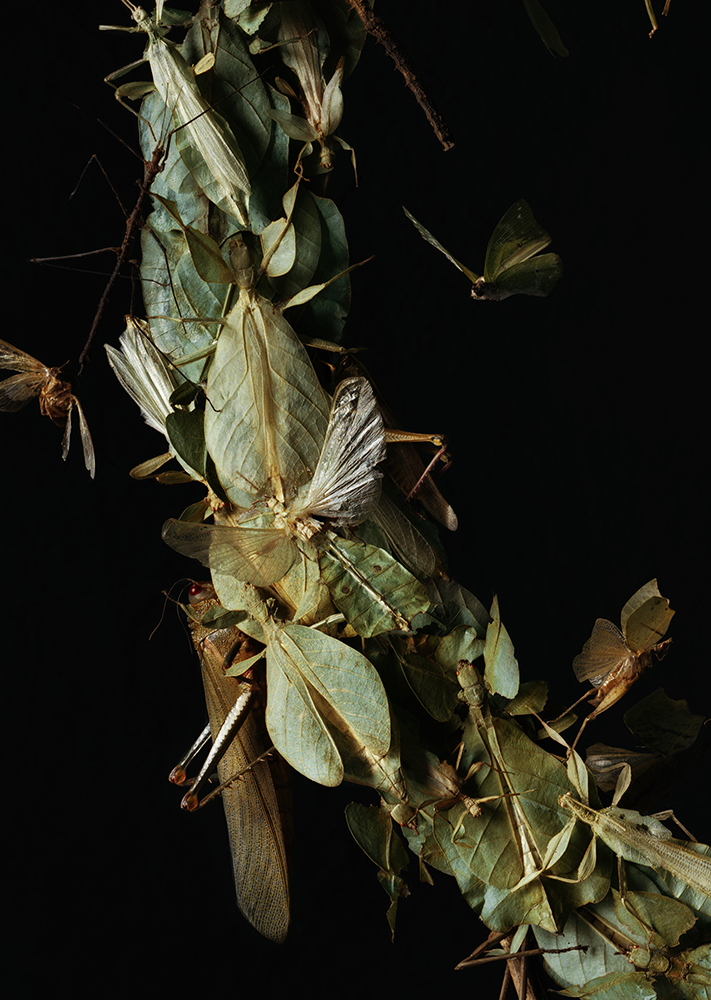
©Tara Sellios, Messis No. 1 (Ask Now the Beasts), 2021, 55×42 inches, inkjet print from 8×10 negative
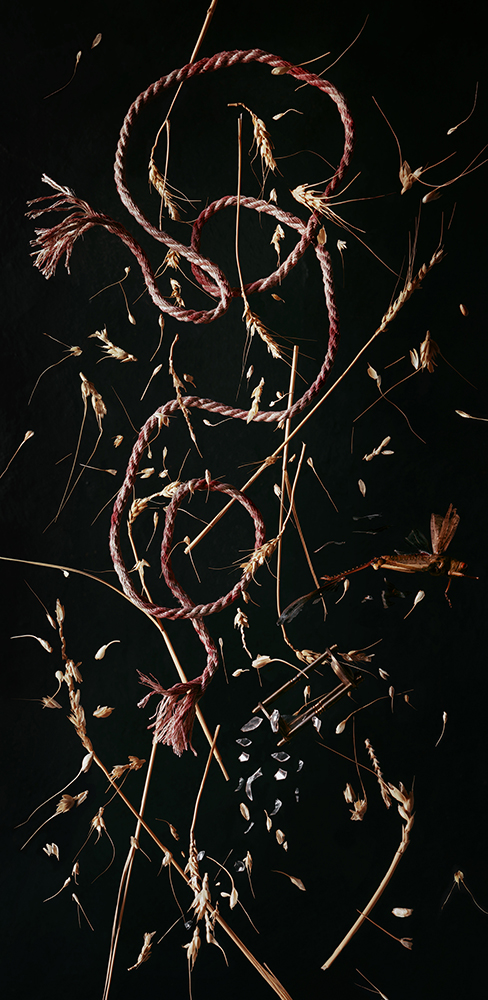
©Tara Sellios, Triticum No. 2 (Ask Now the Beasts), 2023, 80×39 inches, inkjet print from 8×10 negative
KE: The way light plays a role in your photographs is truly beautiful. The juxtaposition between the stark black background and the highlights of the objects creates a dichotomy in the image and brings to mind a conversation about light versus darkness, birth versus growth. Many of the objects in your work are dead and dried yet the way you layer the objects and utilize light gives them a new life. Was this intentional? Did you ever consider using living flora and fauna?
TS: I only use natural light. It is so simple and it just renders objects in a very special way, especially the insects. Ask Now the Beasts has the consistent black background because I wanted it to feel like a void, more of a psychological space. The imagery is emerging out of the darkness and takes a bold stance. Light and dark are not separate and coexist together in a dance. There can’t be one without the other, as the dark makes the light more luminous and vice versa. The past couple of years, I’ve explored this a lot more in reading the texts of Carl Jung and others talking about the shadow in regards to the psyche. Everyone has one and some try to conceal or suppress it more than others.
This series, in an ideal scenario, is intended to be exhibited as a huge altarpiece with the three birds bound with grapevines at the center. The “lighter” images are to be hung on the left while the darker, more downward corresponding images are on the right. Each photograph has its intentional opposite. Vinea, the ornamental grotesque, is to be on top. In thinking about it this way, the project can keep expanding for a long time as I keep getting ideas!
I want the objects to be dead and dried intentionally in this series, but also partly because it is unavoidable. It would be difficult to work with real insects, as a get a lot of them from all over the world and they are quite rare. My previous work was a lot more fleshy, wet and lush with a lot of wine and blood. As I moved away from that work, I entered a new chapter where everything has dried up in an almost apocalyptic way, but where the earth and its creatures start taking over. Although a lot of the objects aren’t physically alive, they are still very much alive in a different way.
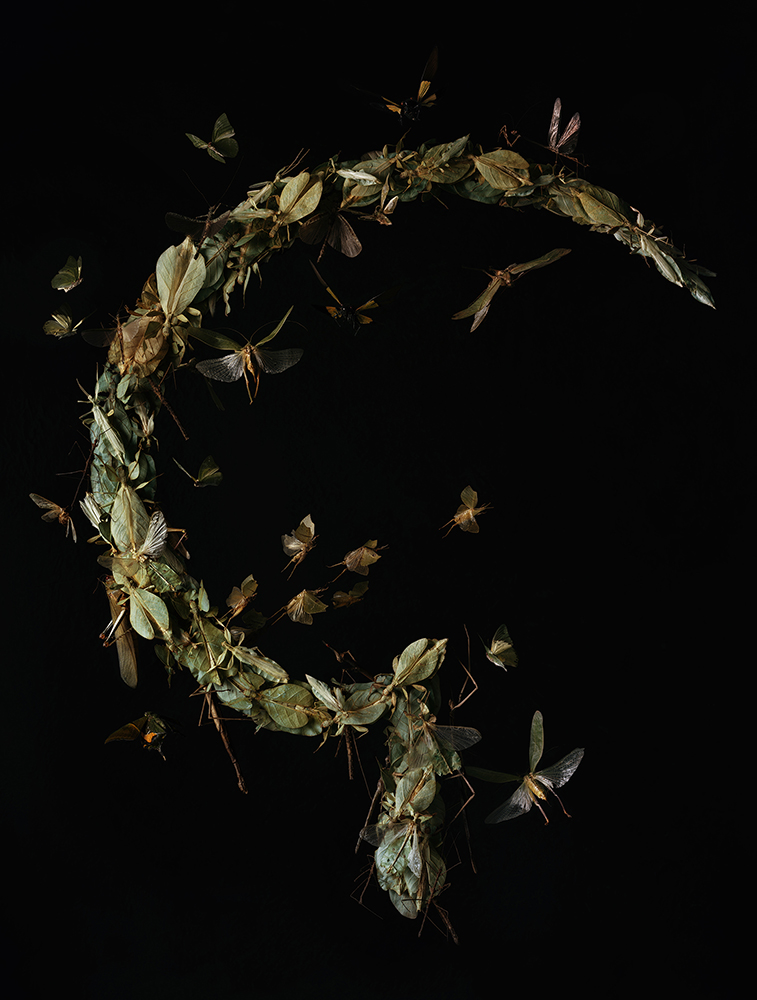
©Tara Sellios, Messis No. 1 (Ask Now the Beasts), 2021, 55×42 inches, inkjet print from 8×10 negative
KE: I see in your statement that you use an 8×10 camera in your work. I’m curious if you used a large format camera for this project and how photographing in this way affected your process.
TS: Ever since I first touched a large format camera, I never looked back. It just suites my process. If I am going to put this much into arranging a scene, it just makes sense for it to be captured with a negative that size, especially since ideally, I like to exhibit the work larger than life. It’s expensive of course, but I only ever shoot one sheet of film per image, so it takes a while to go through. I started out as a painter and photography came later, so I approach my work in the way a painter would in terms of light, color, and texture. An 8×10 negative just renders everything in such a magical way, I couldn’t imagine not using it. The amount of texture and hyper detail is irreplaceable. There’s also something ritualistic and romantic about it to me.
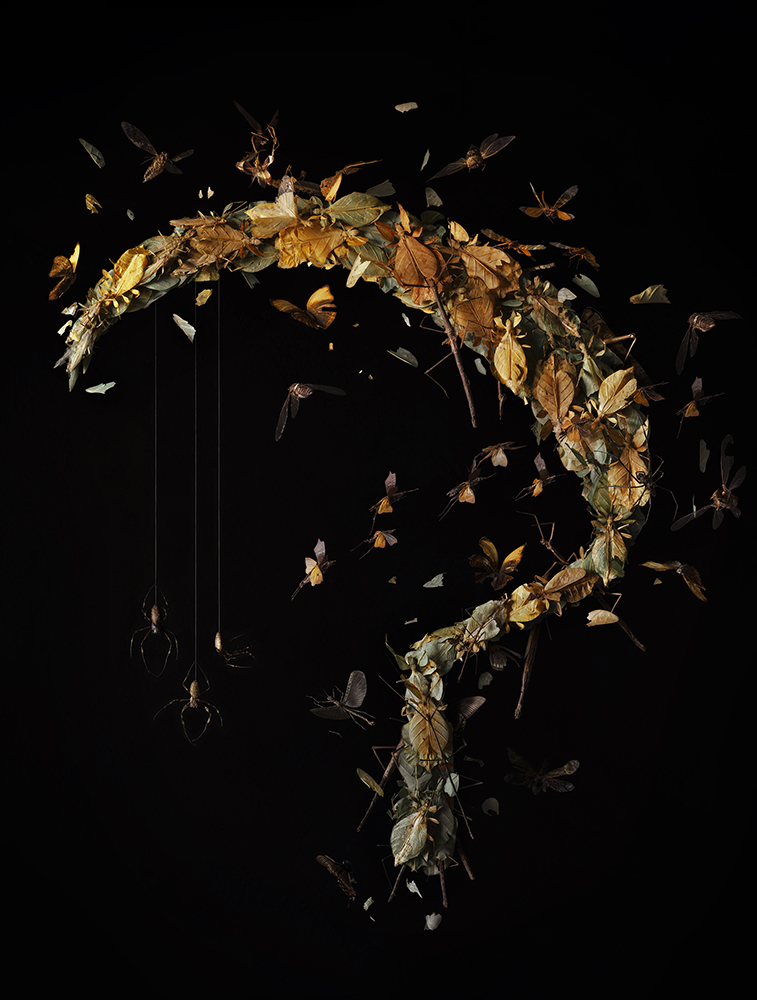
©Tara Sellios, Messis No. 2 (Ask Now the Beasts), 2021, 55×42 inches, inkjet print from 8×10 negative
KE: “Ask Now the Beasts” references the Bible and specifically the book of Job, as you mention in your statement. Many of these compositions and the way you photograph the objects are imbued with these religious themes. Would you elaborate on the idea of how these religious tropes and biblical references inform you and this work? Did you begin this project with the idea to reference religion and these symbols of harvest or did this idea grow as this project progressed?
TS: My work has always had undercurrents (sometimes more blatant, sometimes less so) of Biblical references. It was unavoidable for me I think. I was raised born again Christian in a very intense way and attended church frequently since I was a baby. It was a lot to hear about good and evil, hellfire, punishment, sin, repentance, etc, when you are very young and really don’t understand or know how to rationalize it all. I think my work has always been a method of catharsis but also my way of kind of figuring out what happened, as I internalized a lot of it. All of that being said, I grew up hearing Bible stories continuously – at church, at school, at home, before dinner. I was always taking in that imagery, with all of its vivid language and symbolism. Metaphor is throughout and there are often allusions that are extremely dark and surreal or extremely ethereal and beautiful.
The presence of wine is huge in the Bible in relation to the harvest, but also in various other cultures and practices during that time period and before, which is something I have become more interested in. I recently read a book called Ancient Wine which is a fascinating deep dive into the history of wine, going all the way back to the Neolithic period. Wine and the harvest were sacred, ritualistic and the drink was thought to lead to divine transcendence when consumed. In Ask Now the Beasts, the presence of wine is a very layered motif referencing all of this with imagery of harvesting sickles, vines, wine glasses, etc. I am also thinking of it as this elixir that has been around for so long as a method of intoxication. I just left my bartending career for good after over 15 years of doing it, so that is another unavoidable component. I was around drinking very often in an immediate, visceral way. Lastly, I love wine, probably too much!
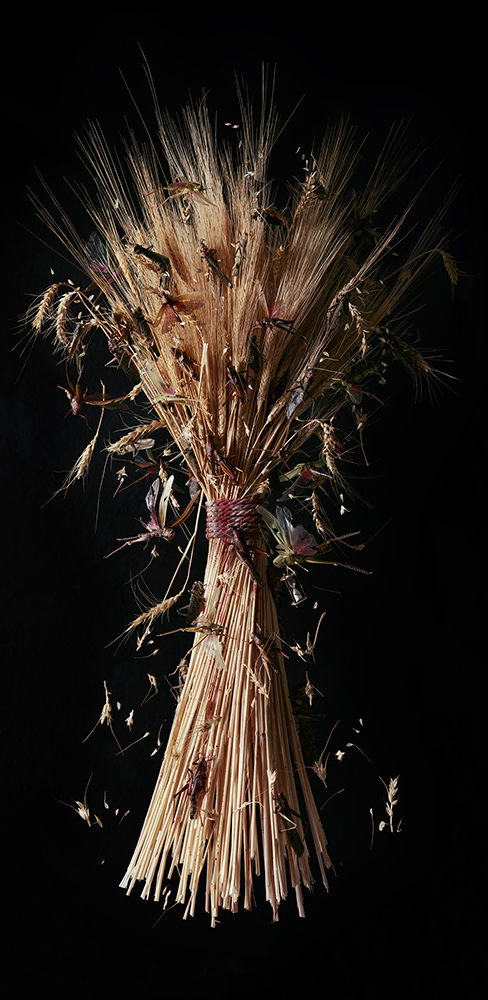
©Tara Sellios, Triticum No. 1 (Ask Now the Beasts), 2023, 80×39 inches, inkjet print from 8×10 negative
KE: I love the notion of the phrase “suffering and death leads to transcendence and transformation” that you provide in your statement. As humans, we tend to elude fear, failure and hardship. Would you discuss your thoughts on failure and hardship as it pertains to your work and your photographic career?
TS: In regards to my art career, fear is a huge factor that I am always trying to keep at bay. It can be so detrimental to creativity and forward motion. I have a strong opinion about fear that the moment because of where I’m at in my life and career. As I mentioned, I supported myself by working as a bartender, mostly in nightclubs and music venues, for over 15 years. It started to affect my health and my artwork until it really reached a boiling point in December where I really had no choice but to leave. I didn’t – and still don’t – have it totally figured out financially (that always seems to be the big problem), but I’m trusting it is the right move and letting go of fear, because it doesn’t help and it isn’t necessarily rooted in reality.
As an artist, you need to be really open to things not going how you planned or how you hoped they would go. Often, what ends up happening is the more suitable, better option. You don’t get the grant, you don’t get the show, the budget isn’t what you thought it would be, things get canceled – the list is endless. It’s easy to get discouraged. Letting go is something I’ve been trying to practice. I find it a lot easier to troubleshoot failure in the studio while working on a piece versus real life, but its doable!
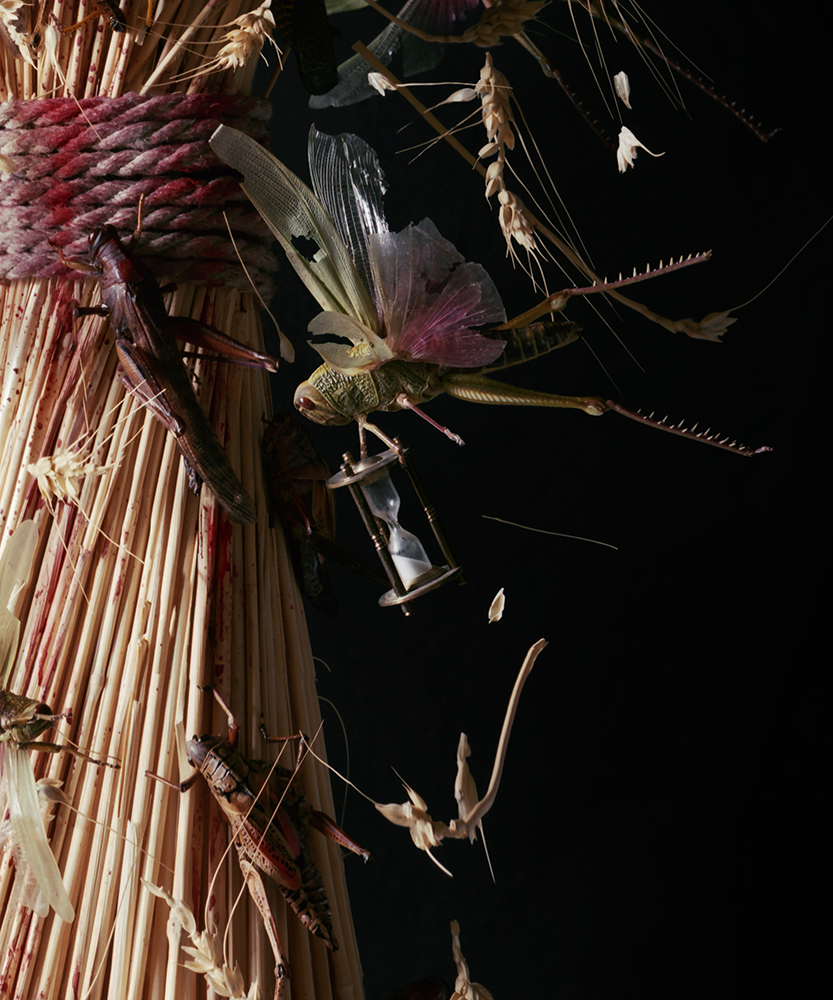
©Tara Sellios, (Detail) Triticum No. 1 (Ask Now the Beasts), 2023, 80×39 inches (full image), inkjet print from 8×10 negative
KE: To conclude I would like to ask what is next for you. Is there anything you are currently working on?
TS: I am working on so many things…I’m at a point where all of my recent projects are kind of “open” and I just keep adding to them depending on the nature of the image. More immediately, I am working on a series Ad Altiora Tendo, meaning “I strive for higher things” in Latin. The series has a lot of deep, rich greens and earth tones. I want it to have an almost psychedelic forest feeling. It explores themes of transcendence through suffering in a more specific, in depth way, and I have a few images planned alluding to the martyrs but with my own spin on it. Martyrs are those who voluntarily suffer as a form of refusal to denounce their faith or comply and ultimately transcend to something higher. There are elements of violence that shows up in the work, but they are ultimately becoming more celebratory, involving more flowers, plants, and musical instruments. I used to spend a lot of time researching Hell in art history and have read Dante’s Divine Comedy a few times. I’m at a point where more and more, I am moving away from Hell and wanting to explore the concept of paradise. I have a lot of work to do and am excited to see how it starts unfolding as time goes on! I have a series that is very blue in mind for that.
I will be part of a group show at the Shelburne Art Museum in Vermont in May and have a solo exhibition at the Fitchburg Art Museum in Massachusetts opening Spring 2025. I will also be teaching my first workshop through Santa Fe Workshops called Craft and Vision in Still-Life Photography here in Boston as a pop up in April, which I’m very excited about. It will be a great learning experience, as I hope to do more teaching work like that.
Posts on Lenscratch may not be reproduced without the permission of the Lenscratch staff and the photographer.
Recommended
-
Salua Ares: Absense as FormNovember 29th, 2025
-
Ricardo Miguel Hernández: When the memory turns to dust and Beyond PainNovember 28th, 2025
-
Pamela Landau Connolly: Columbus DriveNovember 26th, 2025
-
KELIY ANDERSON-STALEY: Wilderness No longer at the Edge of ThingsNovember 19th, 2025
-
Jackie Mulder: Thought TrailsNovember 18th, 2025

